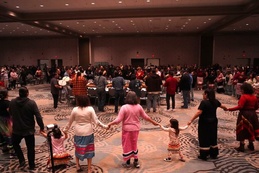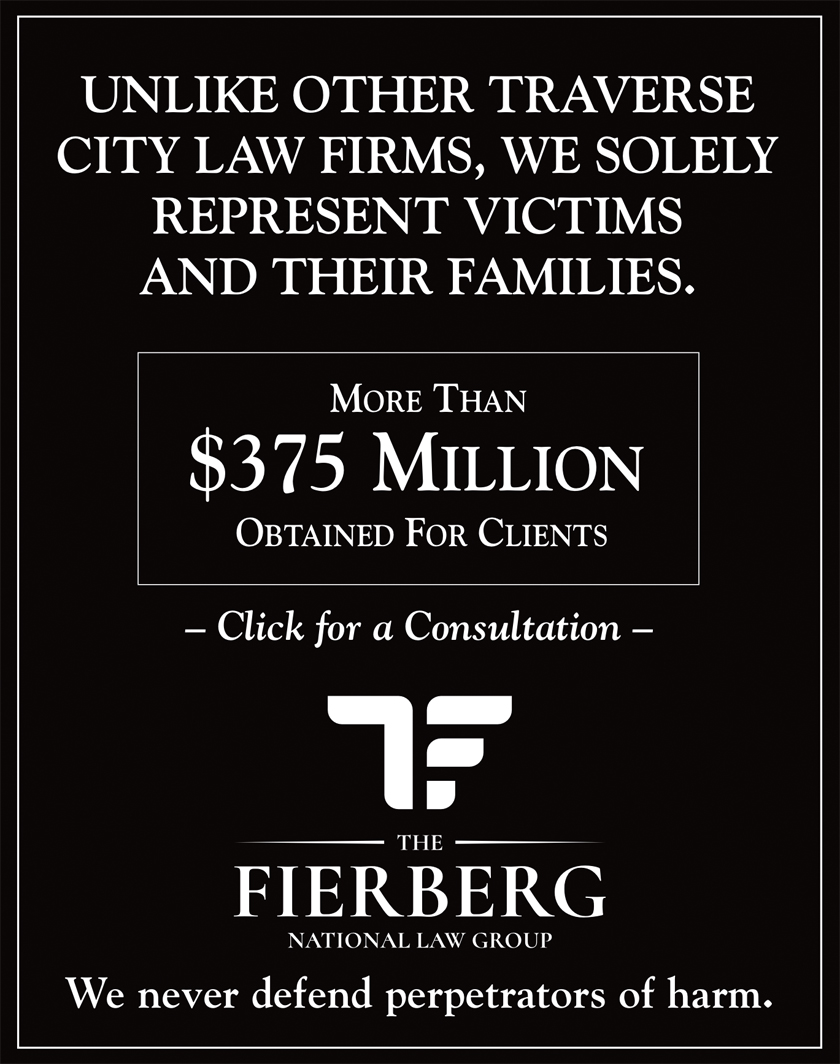
Go inside the 86th
By Patrick Sullivan | Feb. 1, 2020
Michigan’s 105 district courts aren’t the state’s highest or farthest-reaching courts. They’re a starting point, where the accused go to face initial charges, a judge, and sometimes even a jury. District courts are charged with resolving their region’s less serious cases — violations like misdemeanor crimes and traffic offenses — but that doesn’t make them any less significant a place for the people who have to be there. On a recent Tuesday following a long weekend, Northern Express spent a day inside the courtrooms of the 86th District Court in Traverse City to witness what so many of the region’s citizens do. The day was full of twists and turns, sorrow, and some inspiration.
One by one, a group of defendants file into the Traverse City courtroom just past 8am. It’s not the kind of appointment you want to be late for. Twelve arrive from the street and one, in an orange jumpsuit and shackles, from the jail. They are all participants in the 86th District Court’s drug court, a diversion program for defendants who are charged with nonviolent felonies spurred by addiction.
At 8:15am, Judge Robert Cooney enters through a door behind his bench, and the bailiff orders everyone to stand.
The formal atmosphere doesn’t last long, however. Each participant is called up, one after another, to stand before the judge. They greet each another, the judge and the participant, almost casually. Cooney asks them how they’re doing and congratulates them on any progress they’ve made.
Northern Express spent a day at the 86th district court — watching the drama of drug court unfold, catching a couple of pleas in Judge Michael Stepka’s courtroom next door, sitting in on traffic court and sobriety court in the afternoon, and ultimately bearing witness to many of the 33 arraignments that tick through an average day in district court.
District court is a place where long, tedious moments of waiting and mundane process are punctuated by occasional flashes of intense personal drama; a place where people struggling with addiction alternately display the raw horror of their transition to sobriety and their moments of triumph; a place that, perhaps, serves as our society’s final social safety net.
FROM FELONIES TO MISDEMEANORS
The first drug court participant to stand at the podium on this morning was also the one who had been there the longest; he was celebrating a significant milestone.
“Good morning, your honor. How are you?” Nicholas asked.
“Good! How are you?” Cooney said.
“Good.”
After Cooney asked Nicholas how his recovery has been going, Nicholas told Cooney he’s finishing up the Twelve Steps, most recently concentrating on steps 10, 11 and 12 — admitting when he’s wrong, praying for wisdom and strength, practicing the steps’ principals in his day to day. He explained that he’s going to meetings and meets with his sponsor each week.
He also talked about how far he’d come — from viewing the steps with cynicism and scorn to buying in. For example, he said, he had an epiphany at step 4 while taking a moral personal inventory.
“At first when I was starting my inventory, I was like, ‘Oh, this is stupid, why am I doing this?’” the 26-year-old said. “And then when I was finished with it, I was like, ‘Wow, this is really cool.’”
Nicholas’ journey in drug court began in 2017, when sheriff’s deputies visited his home to serve a warrant. According to his case file, the deputies found him with a white powdery substance that would turn out to be methamphetamine; when they went to arrest him, Nicholas froze up and officers took him to the ground.
He was charged with resisting arrest and possession of meth — felonies that could have meant 10 years in prison.
On this day in court, however, Nicholas was able to celebrate a turning point: Cooney announced it was time for Nicholas’ charges to officially be reduced to misdemeanors.
“Congratulations,” Cooney said, with a broad smile.
Nicholas isn’t a drug court graduate yet, but if he continues on successfully, he will have avoided not jail or prison sentence but also the stigma of being branded a convicted felon for the rest of his life.
LOTS OF RULES, BUSY LIVES
Not every case is without complication.
Jacob, a 28-year-old, was up next. He was originally arrested for possession of cocaine and driving with a high blood alcohol content. Today he had to answer for a slip-up that had occurred since his last drug court date.
He’d gotten the flu, he said, and he took some Sudafed. It is forbidden for the participants to take even over-the-counter medicine without permission from the court.
Cooney doesn’t flinch at the admission. He tells Jacob not let it happen again, then moves quickly to focus on the progress Jacob has made in his recovery and encourages him to stay on track.
For the men and women who come before Cooney, staying on track is far easier said than done; their obstacles often go beyond the drugs that led them here. A 31-year-old woman, for instance, was in drug court following her second-offense possession of meth and carrying a concealed weapon charges. She told Cooney she’s been struggling to find the kind of professional job she’s qualified for.
Another man, a 38-year-old transplant from South Carolina who faced a 20-year delivery of methamphetamine charge, told Cooney he’d recently been sledding for the first time in his life; he’d since resolved to quit smoking.
“It’s something that you want to do all the time, and it just makes you angrier more than anything else,” he said.
Cooney noted that quitting nicotine could significantly improve his odds in recovery because statistically, nonsmokers do much better.
Cooney also apologized to the man because a paperwork error by the court had caused the man’s driver’s license to be suspended for an additional 30 days.
“There is very little that I can do about that except explain what happened to the Secretary of State,” he said. “Hopefully we’ve got a real human being down there that’s willing to listen.”
Transportation can be critical for those in recovery. The defendants are sometimes required to be several places on a given day — like NA meetings, drug screens, breath tests, and a job.
In other cases, because of a quirk of the law, drug court participants find themselves in an even greater bind despite following all of the rules: Some have been charged with felonies that don’t require automatic driver’s license suspensions, but when their charges are reduced to misdemeanors, those charges, under state law, require automatic license suspensions.
Mark Risk, whose been with the recovery courts as a defense attorney since 2001, said that it’s a crazy loophole that punishes defendants for good behavior.
MOMENTS OF TRIUMPH AND PAIN
Steve, a 37-year-old who ended up in drug court after being charged with possession of meth, carrying a concealed weapon, and being an habitual offender, stood up to celebrate a recent life change.
He told Cooney that he had recently moved from one halfway house that was filled with parolees who weren’t particularly interested in clean living, into another halfway house that was set up for those in recovery and offers a community of people committed to sobriety and working together.
“It’s an excellent place to live,” he told Cooney.
Cooney noted that as of earlier in the month, Steve celebrated five months of sobriety. The room applauded.
“I feel like I’m getting back to where I was before,” Steve said. “I’m a lot more clear-minded. Stuff matters again.”
Cooney celebrated the milestone by reducing Steve’s mandatory meetings with his probation officer to once per week.
Another participant, a 29-year-old whose charges included firearm theft and receiving stolen firearms, had recently completed 390 days in the program; he’s applied to move onto phase two of the program.
“I feel like I’ve been doing pretty well over the last year. I’m in a completely different space,” he told Cooney.
“Do you feel the urge to use still?” Cooney replied.
“No. It’s been quite a while.”
Cooney told him that the drug court team had met and discussed his case and, because they’d agreed that he was doing extremely well, they would advance him to phase 2, which means he’s is closer to graduating, and there are fewer requirements placed on him.
The man credited his success to treating his recovery like a full-time job.
“The day I got out of jail, I was so stressed out and so overwhelmed with all of the requirements,” he said. “When I was using, that was like a full-time job for me.”
The last defendant to take to the podium was the one wearing jail orange. Kimberly, who got into drug court following cocaine and meth possession charges, was arrested on a probation violation after she was caught forging signatures on her AA attendance sheets. She said she didn’t think she needed AA meeting anymore and that’s why she had stopped going.
Cooney told the 42-year-old that while there was no indication that she was using drugs or alcohol, he worried about her ability to deceive.
“If you’re willing to make up facts to the court, then maybe you’re willing to make up facts to yourself about using drugs,” he told her.
Kimberly apologized — to Cooney, and to her co-defendants: “I know it was wrong. I know better.”
Cooney told her that unless she was some rare exception, she needed those meetings more than she thought, and she was risking her recovery by skipping them.
Cooney sentenced her to time served (she’d been in jail for a week) and ordered her to be under indefinite house arrest. Then he wished her the best.
FOR YOUR SAKE, PLEASE DON’T DRIVE
While the group of drug court participants were inching their way through the long process of resolving their cases, across the open-air waiting area, in another courtroom, Magistrate Tammi Rodgers presided over a docket of defendants whose cases — both civil and criminal — were just beginning.
Because it was the Tuesday after the Martin Luther King Jr. Day holiday, there were plenty of arraignments and hearings to conduct following the long weekend. Some of them were for people who had been arrested over the weekend; others were for folks brought in on bond or probation violation warrants. One was a man extradited from Oklahoma as part of a criminal sexual conduct case from 2016.
First, Rodgers took a traffic court plea from a 28-year-old who pled guilty to driving on a suspended license. He’d recently been pulled over while exiting a Shell station at Chum’s Corners. He said he’s been in a financial hole since being convicted of drunk driving and losing his license years ago. He hasn’t been able to get his license back since.
“My attorney said that he could possibly do it for $1,500, but I don’t have that kind of money,” he told Rodgers.
She pleaded with him to stop driving without a license. She noted that the region has pretty good public transportation.
“Just for your sake, please don’t drive, because it will just make it so much more difficult,” she said.
Next was a pretrial for a man who was charged with aggravated domestic violence for allegedly attacking his wife.
He had already been released on bond. He asked to have the “no contact” order removed from his bond conditions so that he could see his wife. They’d been living together again for over a week — in between the incident and his arrest — and they are raising a special needs child together, his attorney, Shawn Worden, told Rodgers.
The assistant prosecutor, Kyle Attwood, objected.
“It’s not an insignificant assault,” Attwood said. “It was a fairly significant hit or punch to the face. There was a lot of blood.”
Rodgers denied the request to remove the “no contact” order.
A FLURRY OF HEARINGS
Next door, Judge Stepka had finished presiding over the morning’s sobriety court. (While drug court takes defendants charged with felonies that stem from drug addiction, sobriety court is a diversion program for people charged with second- or third-offense drunk driving or, in some cases, operating with a high blood-alcohol content.)
He had two preliminary hearings scheduled at 11am. Neither of the hearings ended up happening.
The first one was for defendant Buck Arthur Fraly, a 49-year-old who is accused of forcing a young boy to perform sex acts. Fraly faces life in prison on charges of first-degree criminal sexual conduct. Shackled in chains, Fraly had a dazed look about him as his attorney, Phil Settles, told Skepka that his client would waive the preliminary hearing. That means his case was bound over to circuit court for trial, and Fraly would be led back to jail.
Next up was Christopher Castillo, who was involved in a highly publicized hit-and-run death case in July. Castillo was accused of “aiding after the fact” — helping his brother after his brother had accidentally struck and killed a man on US-31 in East Bay Township.
Castillo also waived his prelim.
Castillo, who lives in Metro Detroit and has no previous criminal record, hired Detroit attorney Byron Pitts, who struck a deal with prosecutors for Castillo to plead guilty to a misdemeanor in exchange for the dismissal of a felony charge.
Meanwhile, in Rodgers’ courtroom, the 33 arraignments started late in the morning and continued on through the lunch hour.
One woman, who was arrested for larceny in a building, lives in a homeless shelter and would not be able to afford drug screens and daily PBTs if they were made conditions of her bond, said Mattias Johnson, her public defender.
“She has no money for testing, and she will fail bond,” Johnson said.
Prosecutor Attwood objected, noting that the woman had a long history of addiction and arrests.
Rodgers sided with Attwood: “I believe the testing is absolutely necessary, both to assure you appear in court and for public safety.”
Next, the parade of arraignments continued, now over a large flat screen television hanging on the wall of the courtroom. Twenty-six defendants were in jail and needed to be arraigned, and they appeared in court through video uplink from a conference room in the jail.
SNOWBALLING TRAFFIC FINES
In the afternoon, Rodgers presided over traffic court, an expedited court for people charged with misdemeanor crimes like driving with a suspended license or without insurance.
This group of defendants, for the most part, live at the margin of society, barely able to pay their bills. Once legal trouble arises, the cost can snow-ball and the debt can become ruinous.
Recognizing the precarious place most of these defendants live in, the court and the prosecutor’s office created traffic court so that many of these cases can plead down to civil infractions and the fines and costs can be kept minimal. In case after case, Rodgers talked to the defendants about how long it would take them to pay the couple hundred dollars in fines and costs and when they expected to next receive income; in effect she helped design payment plans for them.
As they pled guilty to lesser charges, defendant after defendant explained how they were in a bind and needed to drive, despite having no license or no registration, how they somehow caught the attention of a cop and got pulled over, and how their financial life was stretched to the limit – they just could not afford to keep the license and registration up-to-date and afford to keep a vehicle running, something they needed to get to work so that they could pay the fines.
Rodgers spent most of the early afternoon repeating her earlier request: she pleaded, over and over, for the defendants to stop driving until they had a license and registration and insurance.
Rodgers also stressed how important it was for them to pay their court fines by the deadline – failing would do so would lead to a court date; failing to show up for that could lead to jail, and even more money owed.
END OF THE DAY? RESULTS, HOPEFULLY
Most afternoons, Cooney’s and Stepka’s courtrooms are set aside for trials. Most of those trials get settled and never happen. Cooney said that gives him afternoons to prepare for the next morning’s docket of court hearings.
On this Tuesday, however, Stepka presided over sobriety court. There are morning and afternoon sessions of sobriety court in order to accommodate people’s work schedules.
Sobriety court has a steady rhythm, a carousel of people stepping up to the podium one at a time to talk to the judge, answer a couple questions, get congratulated for progress, and move on.
Even when the exchanges touch on failure and punishment – one defendant was ordered to spend a night in jail because he’d missed a PBT, and that had been the latest of several PBTs he’d missed – Stepka also congratulated each one on what progress they had made. He even referred to the jail term as “an overnight” and made sure to schedule it so that the person wouldn’t miss work.
Risk, the recovery court defense attorney, said very little in sobriety court or drug court happens by chance; every aspect of a recovery court hearing has been carefully studied in recent years so that it’s become an environment most likely to result in success.
“Three minutes is optimal at the podium,” Risk said after the hearing, pointing out that each of the ten defendants who appeared that afternoon had been up for roughly that long. “The judge makes three to five positive comments for each negative comment.”
Risk said that statistically, Grand Traverse County’s sobriety court is one of the best in the state, with just a 4.5 percent recidivism rate, compared to an average of 7.5 percent for recovery courts and 46 percent for defendants who don’t take part in a diversion program.
“I believe treatment courts are the greatest thing that has happened to the criminal justice system in the 40 years I have been practicing,” said Risk, who has dedicated his legal career to advocating on behalf of people in crisis. “Under the leadership of Judges Michael Stepka and Robert Cooney we have a great team of professionals involved in 86th District treatment court programs. My proudest accomplishment as an attorney and as a person is being a member of those teams.”
Editor's Note: In the above story, Northern Express isn’t using the full names of defendants except in two cases where the crimes involved are newsworthy, and the names have already been publicized elsewhere.
Trending

Winter Break at the Library
Trying to keep the kids busy while school is out? Head to the library! Dec. 22, take your 12+ tweens and teens to the Mesick… Read More >>
Umbo Is Coming...to The Little Fleet
Winter isn’t just coming—it’s already here. But if you want a break from the December blues, head to The L… Read More >>
GTB Starting the Year with Tradition
The Grand Traverse Band of Ottawa and Chippewa Indians hosts the Kchi Wiikwedong Anishinaabek Maawnjidowin Round Dance on Ja… Read More >>


